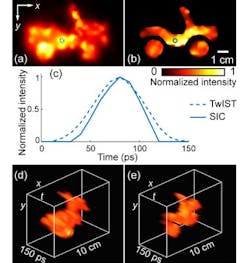Ultrafast receive-only camera gets image-quality boost for tracking neurons
Researchers at Washington University St. Louis (WUSTL; St. Louis, MO) have improved upon a new camera technology that can image at speeds about 100 times faster than current commercial cameras while also capturing more image frames. The new technology opens a host of new possibilities for studying extremely fast processes such as neurons firing, among others.
Related: Microscope records firing of thousands of individual neurons in 3D
The research team, led by Lihong V. Wang, Gene K. Beare Distinguished Professor of Biomedical Engineering, previously developed a single-shot compressed ultrafast photography (CUP) camera that can image at speeds of 100 billion frames/s in a single camera exposure, which is fast enough to capture traveling light pulses. The camera is receive-only, meaning that it can use available light for imaging and does not need any additional illumination from a laser or other light source.
The researchers' method improves the resolution and quality of images captured with CUP. They demonstrate the CUP upgrades by capturing a movie of a picosecond laser pulse traveling through the air and also by pointing laser light onto a printout of a toy car to create a movie of the light reaching different portions of the car at different times.
Wang and his colleagues are particularly interested in understanding how the brain's neural networks operate. Using the new camera with a microscope could allow them to watch neurons fire by capturing extremely fast chemical processes called action potentials that travel through an axon at speeds that can reach more than 100 m/s. Of particular interest to the research team, Wang says, is using the new camera to study a living animal’s neural network in action, which would reveal how the neural network functions and not just how the neurons are connected.
The improved image resolution and quality reported in the researchers' paper describing the work mean that the camera could better capture entire action potential events, including the initiation of the action potentials, propagation with varying speeds, and the termination of signaling. Wang explains that when people study ultrafast biological reactions (faster than standard cameras can image) now, they use a pump-probe method that requires them to repeat the event many times. However, the research team's camera can be used for real-time imaging of a single event, capturing it all in one shot at extremely high speeds, he says.
The original CUP camera adds a second dimension to the one-dimensional view of a streak camera—an extremely fast type of camera that measures the intensity variation of a pulse of light over time. Because this imaging approach does not directly create an image from the raw data acquired by the camera, computer algorithms are necessary to convert the data into an image.
In the new work, the researchers added an external charge-coupled device (CCD) that provides more information for the image reconstruction, leading to a higher-quality image. The researchers also developed a new algorithm to merge the data from the external CCD with the data from the streak camera. With the improvements, the researchers generated images with finer spatial resolution, higher feature contrast, and cleaner background.
The research team is also working toward using their improved CUP camera for bioimaging. They have also been speaking with other scientists who are interested using the fast camera in their applications. In addition, WUSTL has applied for a patent for the technology and is looking for companies to commercialize it.
Full details of the work appear in the journal Optica; for more information, please visit http://dx.doi.org/10.1364/optica.3.000694.

